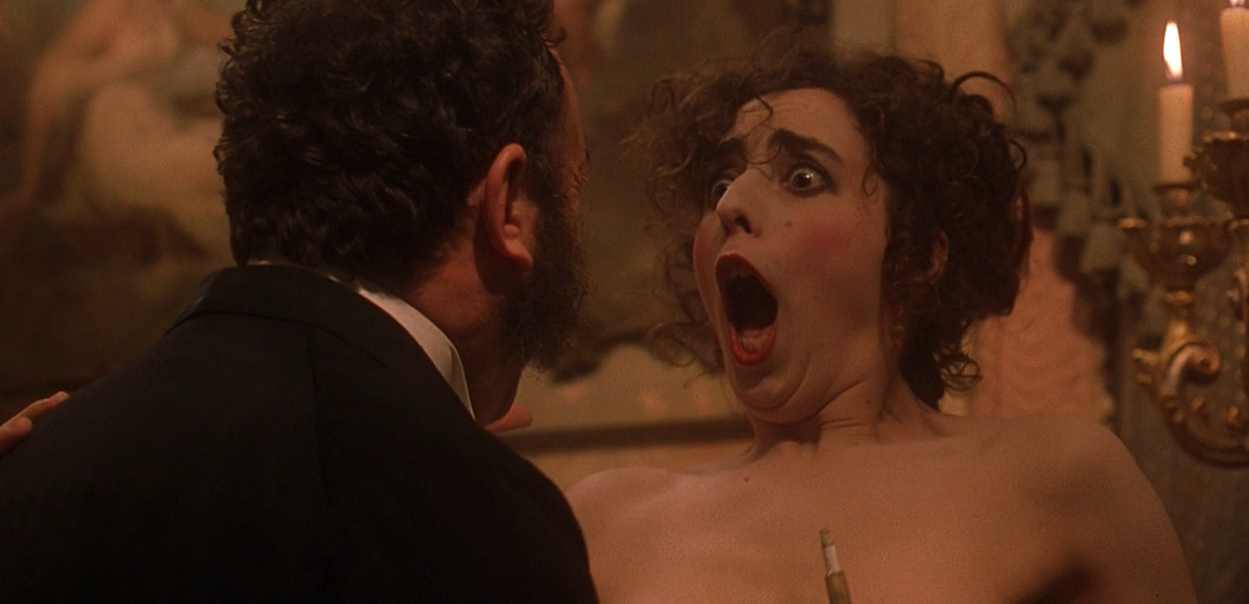In the first moments of the movie Topsy-Turvy—a film I recommend—an obviously ill Sir Arthur Sullivan is stimulated with enough coffee and morphine to revive him sufficiently to conduct the opening night of Gilbert & Sullivan’s comic opera Princess Ida. That history is well evidenced in Sullivan’s diary of 1884. Afterwards, Richard Carte and Helen Lenoir discuss the state of Sullivan’s various running shows with him; that conversation probably didn’t happen but the information they provide is not misleading. Then, bombshell! Sullivan tells them both he will write no more shows for the Savoy Theatre! In real life, that reveal happened later in time, but again it’s solid backstory. (The music there is Sullivan’s moving song The long day closes, which always makes me cry.)
All agree Sullivan should immediately take a vacation on The Continent. He spends some private time with Fanny Ronalds who asks him, “How will you spend your first night of liberty?”
Cut to Sir Arthur Sullivan in a Parisian brothel.
A brothel? Huh? Is that backed up by any sort of evidence?
Don’t get me wrong. As a person who has spent some years reading and studying the diaries of Sir Arthur Sullivan, I am the first person to admit he was a human. He was addicted to gambling, far more than has so far been studied and reported. He was a horrible investor and money manager, whose investment decisions were more or less those of someone you’d imagine was a gambling addict. He did not particularly esteem his nephew Herbert. And yes, he enjoyed sexual relations both within his principal long term relationship with a married woman, and with others.
And yet, I have seen no convincing evidence that he ever employed the services of sex workers. Am I missing something?
Where might such evidence be found? As a quick survey, the biographies of Sir Arthur Sullivan, written by people who knew him are:
Sir Arthur Sullivan; life story, letters, and reminiscences, by Arthur Lawrence (1899)
Sir Arthur Sullivan His Life Letters & Diaries, by Herbert Sullivan and Newman Flowers (1927)
Gilbert, Sullivan, And D’Oyly Carte: Reminiscences of the Savoy and the Savoyards, by Francois Cellier & Cunningham Bridgeman (1914, and 1927)
As you can imagine, none of those mention sex workers. Later in the 20th century we get:
Gilbert & Sullivan : a Biography, by Hesketh Pearson (1954)
Sir Arthur Sullivan, by Percy Marshall Young (1972)
Arthur Sullivan: A Victorian Musician, by Arthur Jacobs (1992)
I haven’t read Hesketh Pearson’s book, and Young’s book is frankly sitting on my nightstand. But Jacobs’ Arthur Sullivan: A Victorian Musician was a game-changer. Unlike Sullivan’s previous biographers, Jacobs not only studied Sullivan’s diaries, he wasn’t afraid to report on what he found therein.
It is Jacobs who first reports that Sullivan may have used some abbreviations and codes to disguise both to whom he corresponded and with whom he had … well, you know. And today, few of us doubt that hypothesis, the evidence is too strong.
Additionally, so far as I know, Jacobs is the first writer to assert that Sullivan visited brothels. A later biography is Michael Ainger’s Gilbert and Sullivan: A Dual Biography (2002). That work is excellent. But for the sex stuff, Ainger simply follows Jacobs.
So was Jacobs really the first person to assert that Sullivan used sex workers? And was he correct?
To the first part of that question, my answer is Yes, but I’d like to know if I am wrong. Please update me! The second part requires more consideration.
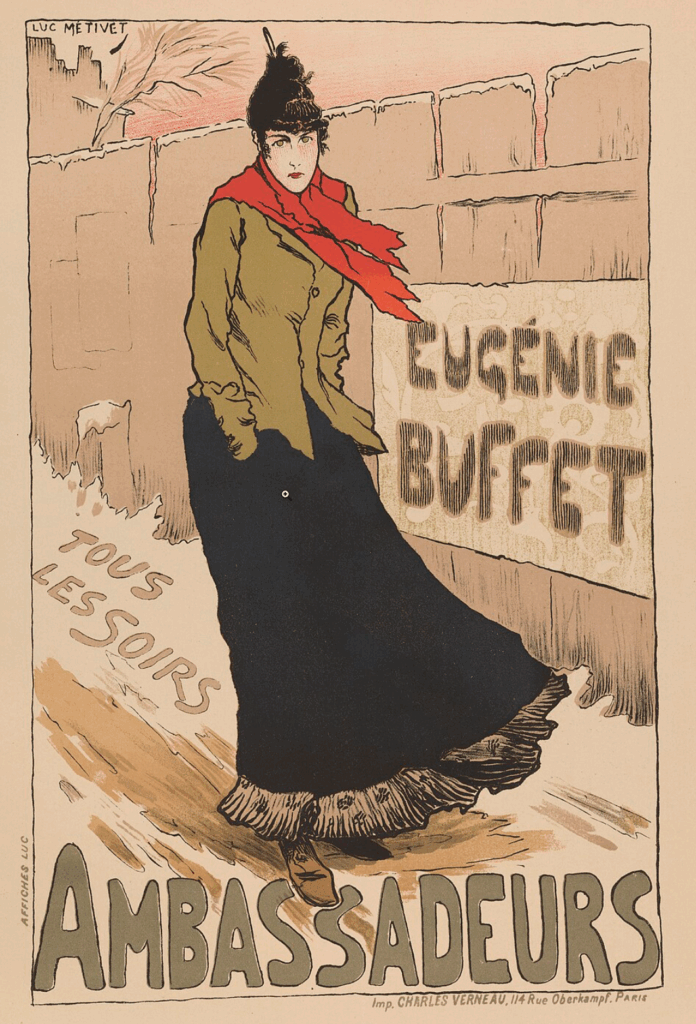
Firstly, regarding Paris: Sullivan generally did not spend long vacations there. He used it as a transit point to various other European destinations, especially the Cote d’Azur and Monaco. While in Paris he usually visited people he knew, or people into whose society he had recently been introduced. This is not to suggest he didn’t have sex there. He and Fanny enjoyed time together in Paris, and he almost certainly had sexual encounters there with other women, such as the cabaret singer Eugénie Buffet. But if he visited brothels in Paris, it is difficult to find those visits in his diaries.
Jacobs gives us two potential brothel visits as evidence. One is at No. 9 Rue de Tilsitt:
14 March, 1887
arr in Paris 9.30. Two hours late. fine
but cold. Went to No. 9 Rue Tilsit[sic]. Dined
with the party at [Marg?] – & to the Renaissance
afterwards to see “Tailleur pour dames”
David Eden debunked this address in Magazine 83 of the Sir Arthur Sullivan Society, by pointing out that 9, Rue de Tilsitt was the home of two enormously wealthy friends of Sullivan, Mr. and Mrs. John Mackay. That hovel is today the Belgian Embassy.
The next possibility is No. 4 Rue “M. T.”
10 April, 1882
Paris arr: at 6 a.m. descended at Grand Hotel – Rooms 197-199. Adèle came at 9. Breakfasted
at Voisin’s at 11. At 12 went to keep appointment at No. 4 Rue M. T.
stayed till 5.30 (2) dined with Dicey & D.H. at Restaurant
Poissonnière. Drove Dicey home, then D.H. (1) then home myself
very tired.
We gadflies might quip that of course he was “very tired”—if we follow the codes, Sullivan had sex three times that day. But there’s another reason he’s fatigued. His arrival in Paris culminates a tiresome train journey from Rome. More on that later.
Many years ago, fascinated by the abbreviated address “Rue M. T.”, I found a map of the streets of Paris from 1882 and searched for any streets that might fit “M.T.” To my surprise, there was only one, the Rue du Mont-Thabor. Even more fortunate, the Rue du Mont-Thabor is one of the shortest streets in Paris. Here’s a contemporary map of the entire street:
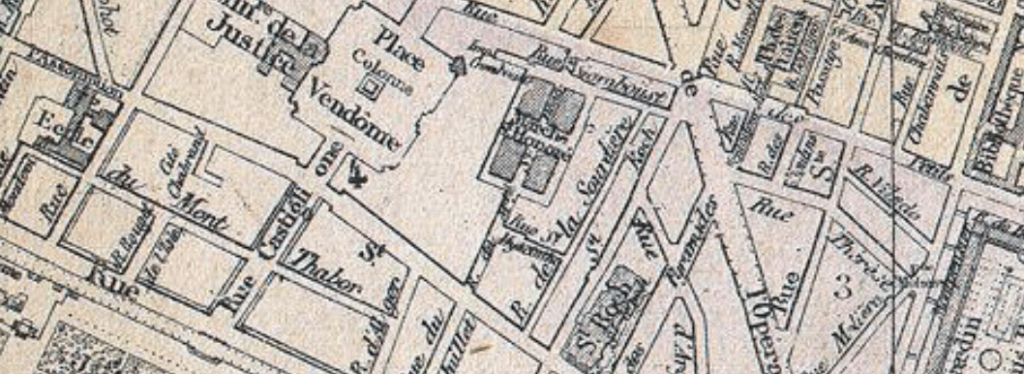
Today, No. 4 Rue M. T. is the site of the Renaissance Paris Vendome Hotel. The building dates from the first half of the nineteenth century, so it is almost certainly the very building Sullivan visited. Even today the location is exclusive (though the hotel is not). From the Rue du Mont-Thabor it is a very short stroll to the Tuileries Gardens and La Place Vendome. This doesn’t feel like a brothel. Next door, in #6, the writer Alfred de Musset died in 1857. Perhaps overcome by sexual ecstasy.
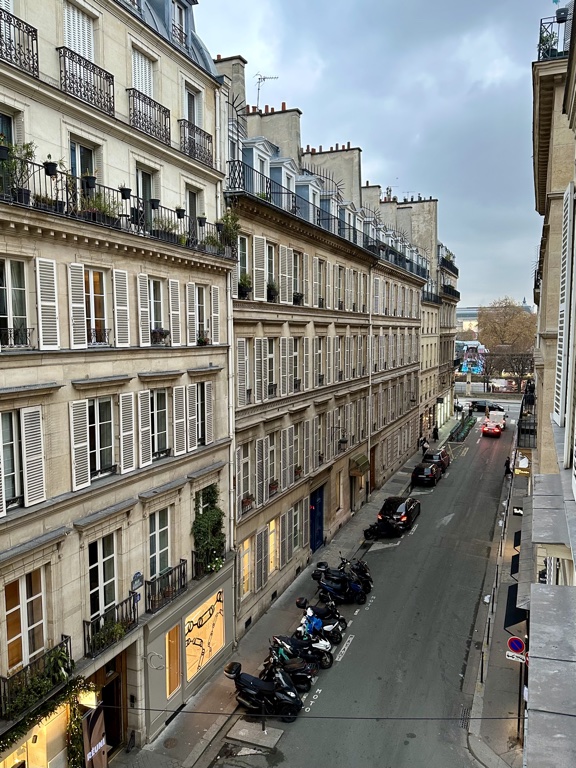
As you can see from the photo, this block of the Rue du Mont-Thabor is a small backstreet, lined with upper middle class apartment buildings, yet it lies steps away from some of Paris’s grandest addresses. Sullivan was staying at his usual accommodations, the Grand Hotel. That palace is but a ten-minute walk away.
In the diary entry, we read that Sullivan “dined with Dicey & D.H.” That’s Ed Dicey, one of Sullivan’s closest friends. Back in London, Dicey often dined with Sullivan and Fanny Ronalds, at her home. Sullivan then writes, “Drove Dicey home, then D.H. (1) then home myself.” It appears that Dicey, D.H., and Sullivan were all staying at different addresses. And following “the code”, we see that Sullivan and D.H. got it on, at her place, wherever that was.
There is a lot more to this story, which I will continue in my next post. But first, I wonder if ChatGPT could effectively replace me as a researcher:
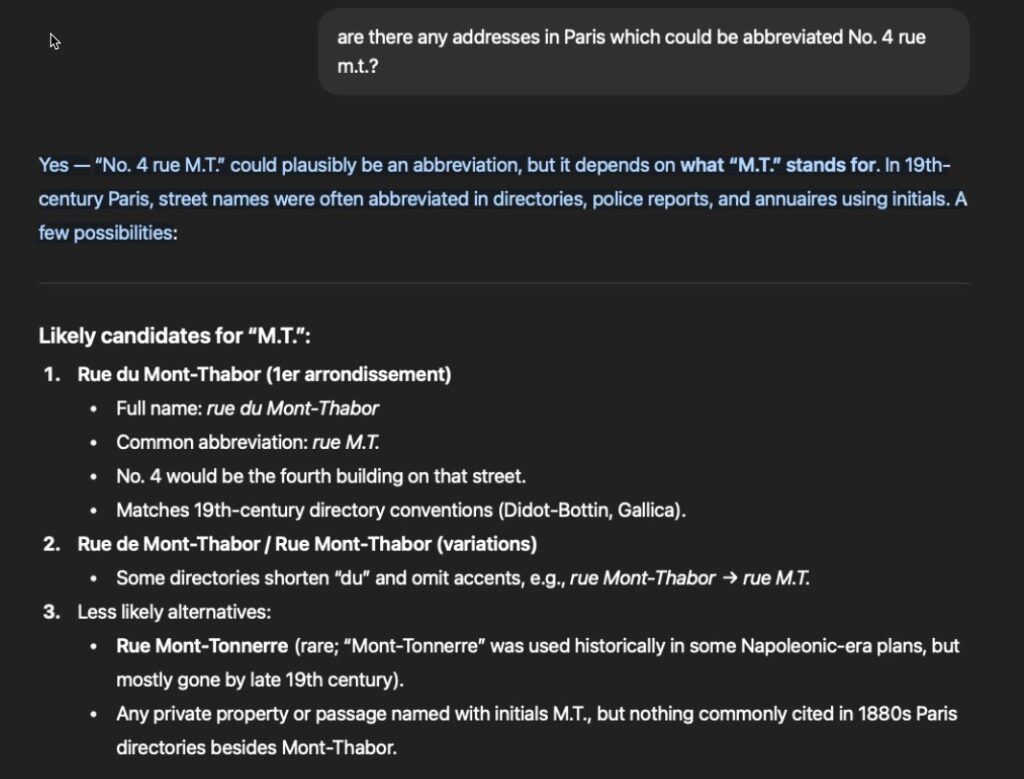
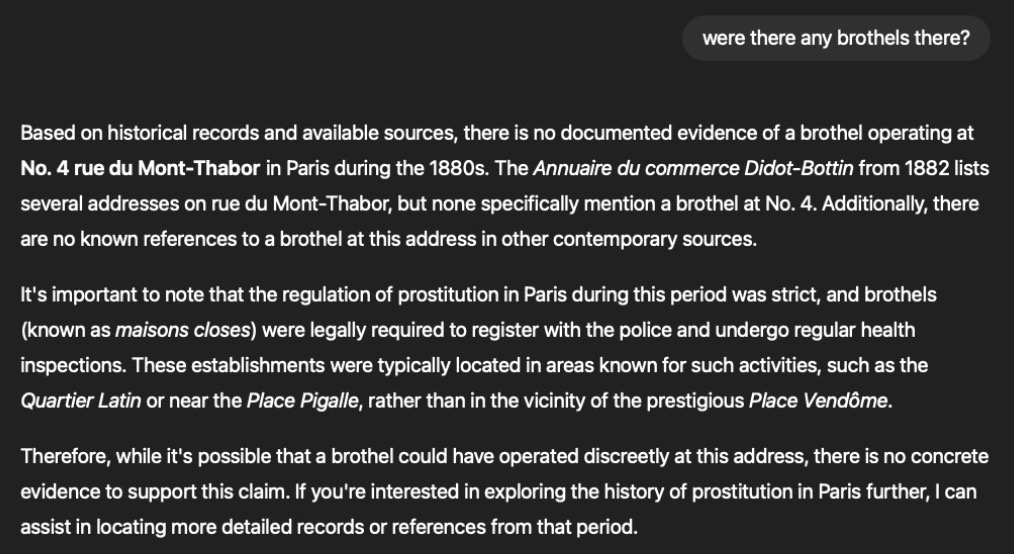
Huh! Who knew?

